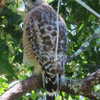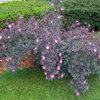Lately I've been getting interested in Rosa foetida and its relatives. These roses are famous for their yellow flowers, odd smell, and susceptibility to black spot, which perhaps don't sound like much of a basis on which to build a passion. But I've had R. foetida and its double form 'Persian Yellow' in the garden for about five years, 'Austrian Copper' for two or three (it's still puny) and I'm becoming enthusiastic about them. The first two are own root and after some years of slow growth are beginning to put out two or three six-foot canes each and sucker a little out from the base. They're planted in extremely heavy soil in full sun and wind; a difficult site in which few roses are happy, but the Foetidas look just fine. They don't get disease. The wood is a smooth bright reddish brown and the foliage is likewise bright, a lettuce green that doesn't go with anything else in the garden; and of course the flowers are the vividest yellow in nature, or out of it if it comes to that. I've read that the plants are best left unpruned, and I only remove old small dead growth.
At this point in their development these roses look like they're going to grow into rock-solid healthy handsome shrubs that are like no other roses in the garden. I have a particular reason for my interest. The last few years we've gotten cane girdler in the garden. Roses differ in their susceptibility to it, but my major victims have been 'Canary Bird', a glorious early species yellow, and the Spinosissimas. The Foetidas seem not to be susceptible at all: the only yellow species/species hybrids I have of which this is true.
I haven't heard of many Foetida hybrids--roses close in character to the species parent--but there are a few. 'Star of Persia', 'Le Reve', 'Lawrence Johnston', are all on my want list, and I already have the lovely 'Wildenfels Gelb'. Funny that 'Harison's Yellow' only just occurred to me! Perhaps it's less widely available here in Europe, being an American variety? Okay...added.
Melissa
P.S While I was writing this I vaguely recalled that I had written another post on Foetidas a while back. I looked it up, and I had written it almost exactly a year ago. There must be something about late winter that gets me going on these roses. Anyway, it seemed reasonable to put in a word for them again. They're great roses for dry summer climates.







jeannie2009
roseseek
Related Discussions
Wanted: Passiflora foetida, pink form
Q
This morning I stepped outside
Q
Dorstenia foetida
Q
Have you seen it bloom?
Q
professorroush
melissa_thefarmOriginal Author
mariannese
melissa_thefarmOriginal Author